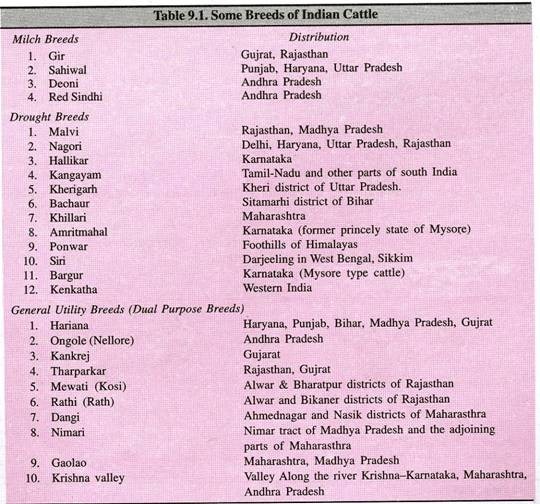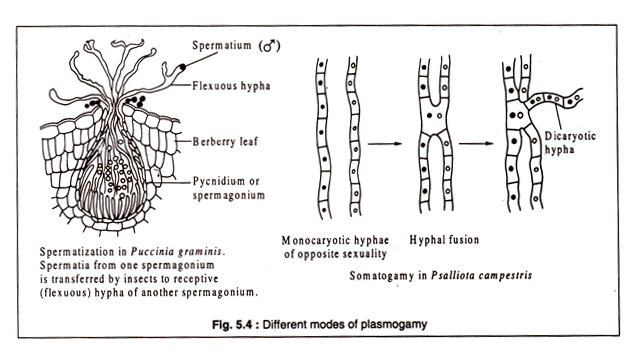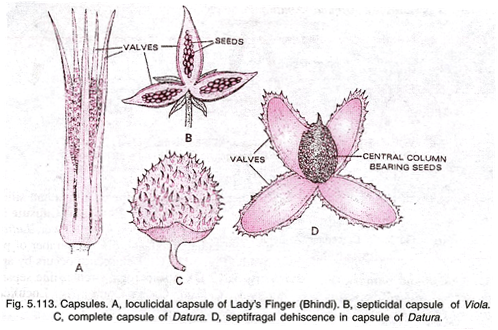ADVERTISEMENTS:
In this article we will discuss about:- 1. Definition of Bacteria 2. Morphology of Bacteria 3. General Methods of Classification 4. Nutrition, Respiration and Reproduction 5. Staining 6. Biochemical Test.
Contents:
- Definition of Bacteria
- Morphology of Bacteria
- General Methods of Classifying Bacteria
- Nutrition, Respiration and Reproduction in Bacterial Cell
- Staining of Bacteria
- Biochemical Tests for Identification of Bacteria
1. Definition of
Bacteria:
ADVERTISEMENTS:
Bacteria are microscopic unicellular organism they are true living organism that belongs to the kingdom prokaryotes.
(Singular: bacterium) are a large group of unicellular microorganisms. They are extremely tiny thus they cannot be seen individually unless viewed through microscope. When cultured on agar, the bacteria grow as colonies that contain many individual cells. These colonies appear as spots of varying size, shape and colour, depending on the microorganism.
2. Morphology of Bacteria:
Bacteria are very small unicellular microorganisms ubiquitous in nature. They are micrometres (1μm = 10-6 m) in size. They have cell walls composed of peptidoglycan and reproduce by binary fission. Bacteria vary in their morphological features.
The Most Common Morphologies are:
ADVERTISEMENTS:
Coccus (Pleural – Cocci):
Spherical bacteria; may occur in pairs (diplococci), in groups of four (tetracocci), in grape-like clusters (Staphylococci), in chains (Streptococci) or in cubical arrangements of eight or more (sarcinae).
For example – Staphylococcus aureus, Streptococcus pyogenes.
Bacillus (Pleural – Bacilli):
Rod-shaped bacteria; generally occur singly, but may occasionally be found in pairs (diplo-bacilli) or chains (streptobacilli).
For example – Bacillus cereus, Clostridium tetani.
Spirillum (Pleural – Spirilla):
Spiral-shaped bacteria.
For example – Spirillum, Vibrio, Spirochete species.
ADVERTISEMENTS:
Some Bacteria have Other Shapes Such as:
Coccobacilli – Elongated spherical or ovoid form.
Filamentous – Bacilli that occur in long chains or threads.
ADVERTISEMENTS:
Fusiform – Bacilli with tapered ends.
(i) Most numerous organisms on earth.
(ii) Earliest life forms (fossils date 2.5 billion years old).
ADVERTISEMENTS:
(iii) Microscopic prokaryotes (no nucleus non membrane-bound organelles).
(iv) Contain ribosomes.
(v) Infoldings of the cell membrane carry on photosynthesis and respiration.
(vi) Surrounded by protective cell wall containing peptidoglycan (protein- carbohydrate).
ADVERTISEMENTS:
(vii) Many are surrounded by a sticky, protective coating of sugars called the capsule or glycocalyx (can attach to other bacteria or host).
(viii) Have only one circular chromosome.
(ix) Have small rings of DNA called plasmids.
(x) May have short, hair like projections called pili on cell wall to attach to host or another bacteria when transferring genetic material.
(xi) Most are unicellular.
(xii) Found in most habitats.
ADVERTISEMENTS:
(xiii) Most bacteria grow best at a pH of 6.5 to 7.0.
(xiv) Main decomposers of dead organisms so recycle nutrients.
(xv) Some bacteria breakdown chemical and oil spills.
(xvi) Some cause disease.
(xvii) Move by flagella.
ADVERTISEMENTS:
(xviii) Some can form protective endospores around the DNA when conditions become unfavorable; may stay inactive several years and then re-activate when conditions favorable.
(xix) Classified by their structure, motility (ability to move), molecular composition, and reaction to stains (Gram stain).
(xx) Grouped into 2 kingdoms – Eubacteria (true bacteria) and Archaebacteria (ancient bacteria).
(xxi) Once grouped together in the kingdom Monera.
(xxii) Classified by their structure, motility (ability to move), molecular composition, and reaction to stains (Gram stain).
(i) Found in harsh environments (undersea volcanic vents, acidic hot springs, salty water).
(ii) Cell walls without peptidoglycan.
(iii) Subdivided into 3 groups based on their habitat — methanogens, thermoacidophiles, and extreme halophiles.
(i) Live in anaerobic environments (no oxygen).
(ii) Obtain energy by changing H2 and CO2 gas into methane gas.
(iii) Found in swamps, marshes, sewage treatment plants, digestive tracts of animals.
(iv) Break down cellulose for herbivores (cows).
(v) Produce marsh gas or intestinal gas (methane).
(i) Live in very salty water.
(ii) Found in the Dead Sea, Great Salt Lake, etc.
(iii) Use salt to help generate ATP (energy).
Thermoacidophiles (Thermophiles):
(i) Live in extremely hot (110°C) and acidic (pH 2) water.
(ii) Found in hot springs in Yellowstone National Park, in volcanic vents on land, and in cracks on the ocean floor that leak scalding acidic water.
Kingdom Eubacteria (True Bacteria):
(i) Most bacteria in this kingdom.
(ii) Come in 3 basic shapes — cocci (spheres), bacilli (rod shaped), spirilla (corkscrew shape).
(iii) Bacteria can occur in pairs (diplo – bacilli or cocci).
(iv) Bacteria occurring in chains are called strepto – bacilli or cocci.
(v) Bacteria in grapelike clusters are called staphylococci.
(vi) Most are heterotrophic (can’t make their own food).
(vii) Can be aerobic (require oxygen) or anaerobic (don’t need oxygen).
(viii) Subdivided into 4 phyla – Cyanobacteria (blue-green bacteria), Spirochetes, Gram-positive, and Proteobacteria.
(ix) Can be identified by Gram staining (gram positive or gram negative).
(i) Gram negative.
(ii) Carry on photosynthesis and make oxygen.
(iii) Called blue-green bacteria.
(iv) Contain pigments called phycocyanin (red and blue) and chlorophyll a (green).
(v) May be red, yellow, green, brown, black, or blue-green.
(vi) Some grow in chains (e.g. Oscillatoria) and have specialized cells called heterocyst that fix nitrogen.
(vii) First bacteria to re-enter devastated areas.
(viii) Anabaena that lives on nitrates and phosphates in water can overpopulate and cause “population blooms” or eutrophication.
(ix) After eutrophication, the cyanobacteria die, decompose, and use up all the oxygen for fish.
(i) Gram positive.
(ii) Have flagella at each end so move in a corkscrew motion.
(iii) Some are aerobic (require oxygen); others are anaerobic.
(iv) May be free-living, parasitic, or live symbiotically with another organism.
(i) Largest and most diverse bacterial group.
(ii) Subdivided into Enteric bacteria, Chemoautotrophic bacteria, & Nitrogen- fixing bacteria.
Enteric Bacteria:
(i) Gram negative heterotrophs.
(ii) Can live in aerobic and anaerobic environments.
(iii) Includes E. coli that lives in the intestinal tract making vitamin K and helping break down food.
(iv) Salmonella causes food poisoning.
(i) Gram negative bacteria that obtain energy from minerals.
(ii) Iron-oxidizing bacteria found in freshwater ponds use iron salts for energy.
(i) Rhizobium is Gram negative and live in legume root nodules.
(ii) 80% of atmosphere is N2, but plants can’t use nitrogen gas.
(iii) Nitrogen-fixing bacteria change N2 into usable ammonia (NH3).
(iv) Important part of the Earth’s nitrogen cycle.
3. General Methods of Classifying Bacteria:
(i) The Intuitive Method:
Since a large array of microbiologists study the characteristics of organisms (morphological, physiological, biochemical, genetical, molecular), sometimes, it is difficult to assign an organism based on all the characters because a character may be important to a particular microbiologist may not be that important to another, hence, different taxonomists may arrive at very different groupings. Sometimes, this approach i.e. intuitive method is found useful.
(ii) Numerical Taxonomy:
This is based on several characteristics for each strain and each character is given equal weightage.
The % similarity of each strain may determine by the following formula:
% S = NS / (NS + ND)
Where
NS = Number of characteristics for each strains which are similar or dissimilar.
ND = Number of characteristics that are dissimilar or different.
On the basis of % S, S = Similarity if it is high to each other, placed into groups larger and so on.
4. Nutrition, Respiration and Reproduction in Bacterial Cell:
Methods of Nutrition:
(i) Saprobes feed on dead organic matter.
(ii) Parasites feed on a host cell.
(iii) Photoautotrophs use sunlight for energy, but get carbon from organic compounds (not CO2) to make their own food.
(iv) Chemoautotrophs obtain food by oxidizing inorganic substances like sulfur, instead of using sunlight.
(i) Obligate aerobic bacteria can’t live without oxygen; (tuberculosis bacteria).
(ii) Obligate anaerobes die if oxygen is present; (tetanus bacteria that causes lockjaw).
(iii) Facultative anaerobes do not need oxygen, but don’t die if oxygen is present; (E. coli).
(iv) Anaerobes carry on fermentation, while aerobes carry on cellular respiration.
Bacterial Reproduction and Genetic Recombination:
(i) Most bacteria reproduce asexually by binary fission (chromosome replicates and then the cell divides).
(ii) Bacteria replicate (double in number) every 20 minutes under ideal conditions.
(iii) Bacteria contain much less DNA than eukaryotes.
(iv) Bacterial plasmids are used in genetic engineering to carry new genes into other organisms.
(v) Bacteria recombine genetic material in 3 ways – transformation, conjugation, and transduction.
(i) Sexual reproductive method.
(ii) Two bacteria form a conjugation bridge or tube between them.
(iii) Pili hold the bacteria together.
(iv) DNA is transferred from one bacteria to the other.
(i) Bacteria pick up pieces of DNA from other dead bacterial cells.
(ii) New bacterium is genetically different from original.
(i) A bacteriophages (virus) carries a piece of DNA from one bacteria to another.
(ii) Human insulin is produced in the lab by this method.
(i) Known as germs or pathogens.
(ii) Cause disease.
(iii) Can produce poisonous toxins.
(iv) Endotoxins are made of lipids and carbohydrates by Gram – bacteria and released after the bacteria die (cause high fever, circulatory vessel damage).
(v) E. coli produces endotoxins
(vi) Exotoxins are made of protein by Gram + bacteria.
(vii) Clostridium tetani produce exotoxins.
(viii) Antibiotics interfere with cellular functions (Penicillin interferes with synthesis of the cell wall; tetracycline interferes with protein synthesis).
(ix) Some antibiotics are made by bacteria or fungi.
(x) Broad-spectrum antibiotics affect a wide variety of organisms.
(xi) Bacteria can mutate and become antibiotic resistant (often results from over use of antibiotics).
5. Staining of Bacteria:
Bacteria are very small and colourless. They can be observed by making hanging drop slide. One advantage of the stained bacteria smear slide over hanging drop slide is bacteria is more visible strained bacteria smear are useful in helping to classify and identify bacteria. The most important strain employed in bacteriology is gram staining and ziehl neelsen stain.
For staining of bacteria generally basic dye e.g. methylene blue, methyl violet, crystal violet and basic fuchsine solution and sometime along with a mordant e.g. I2 used to fix the dye. In basic dye the positively charge colour compound combine with negatively charge group in the bacterial protoplasm.
For staining of bacteria smear should be prepared on slide and then it must be fixed on the slide.
1. A minute amount of bacterial growth was transferred into grease free slide containing one drop of saline or water.
2. If bacteria are in the broth culture or liquid specimen like pus in that case one to two loops of bacteria to be taken on slide than the sample spread in a thin layer on that slide and dried in air.
3. The loop was again sterilized by heating (red hot). Film was fixed by quickly passing the slide fire to six times through the upper portion of flame. This prevents the film from being washed off during the staining process.
Simple Staining:
1. Simple staining done by application of single dye solution on bacterial smear (dye may be dilute (1:10) carbol fuchsine or methelene blue.
2. After application of dye wait for 30 sec then washed with tap water to remove the excess dye.
3. Then dry in air and observed under microscope by using 45 and 100 power (oil immersion) lens.
Observation:
When methylene blue used then bacteria stained blue but for carbol fuchsine staining bacteria stained red colour.
Preparation of Methelene Blue Solution:
M.B = 1 gm.
Water = 200 ml.
Dissolve it.
6. Biochemical Tests for Identification of Bacteria:
I. Sugar Fermentation Test:
Carbohydrates are organic molecules that contain carbon hydrogen & oxygen in the ratio (CH2O). Chemical reaction which release energy from the complex, organic molecules decomposition are referred to as catabolism. Organism use carbohydrate differently depending upon their enzyme complement.
Glucose after entering a cell can be catabolized either aerobically or anaerobically or both pathways .The metabolic end products of carbohydrate fermentation can be either organic acid (e.g. Lactic, formic or acetic) or gas (hydrogen or CO2).
Fermentative degradation of various carbohydrates such as glucose, Sucrose, cellulose by microbes, under anaerobic condition is carried out in a fermentation tube. A fermentation tube is a culture tube that contains a Durham tube (i.e. a small tube placed in an inverted position in the culture tube) for the detection of gas production as an end product of metabolism.
The fermentation broth contain specific carbohydrate(glucose, lactose, maltose, sucrose or mannitol and a pH indicator (phenol red).which is red of a neutral pH(7) and turns yellow at or below a pH of 6.8 due to the production of an organic acid.
II. Catalase Test:
During aerobic respiration in the presence of O2, microorganisms produce H2O2 which is lethal to the cell the enzyme catalase present in some microorganism breaks down hydrogen peroxide to water and oxygen as,
Procedure:
III. Oxidase Test:
This test is used to identify microorganisms containing the enzyme cytochrome oxidase (important in the electron transport chain). It is commonly used to distinguish between oxidase negative Enterobacteriaceae and oxidase positive Pseudomadaceae.
Procedure:
IV. Urease Test:
Urea is a major organic waste product of protein digestion in most vertebrate and is excreted in the urine. Some microorganism’s lane the ability to produce the enzyme urease. The urease is a hydrolytic enzyme which attacks the carbon of nitrogen bond amide compound.
Prepare Medium Urea agar medium:
Add to the molten base and steam for 1 hour, cool to 50°c. Urea 20% aqueous solution 100ml. Sterilize by filtration and add aseptically to the basel medium.











